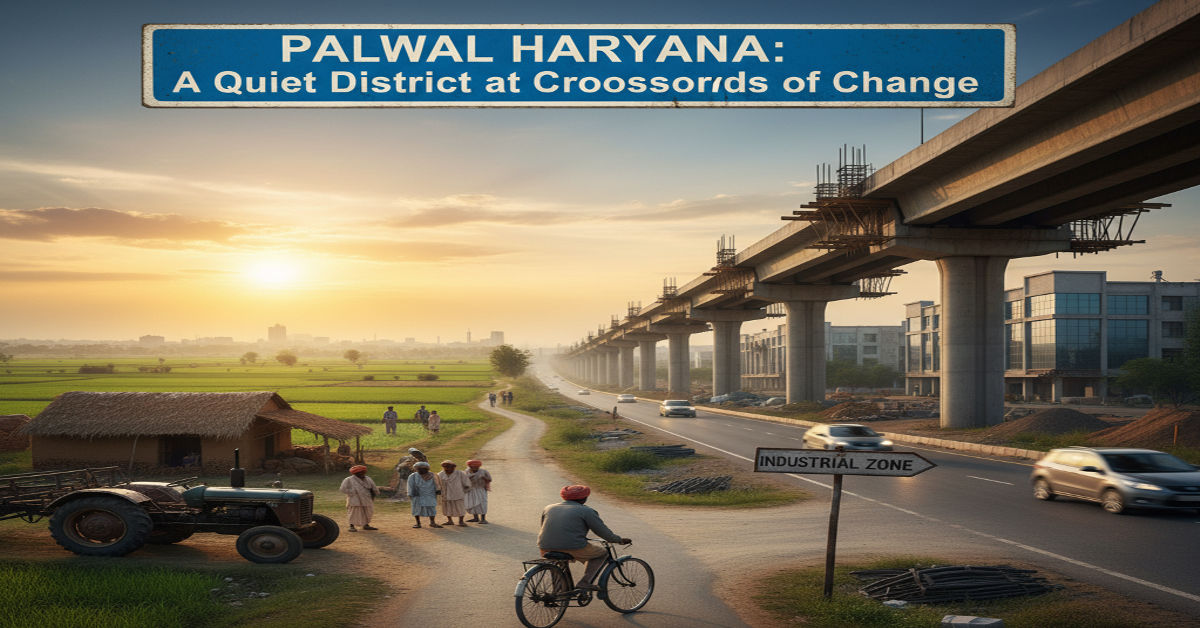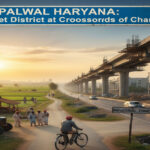Barely sixty kilometers south of Delhi, Palwal Haryana sits on the edge of India’s capital region — close enough to feel the urban pulse, yet distant enough to retain its rural soul. Once known mainly for its fields of wheat, cotton and mustard, this small district has begun to reimagine itself as a connector — between past and future, farmland and factory floor, village and suburb.
For readers seeking context, Palwal is one of Haryana’s younger districts, carved out in 2008 from the larger Faridabad region. It covers roughly 1,350 square kilometers with a population that crossed one million in the last census. The district’s story mirrors that of many Indian towns pulled into the orbit of the National Capital Region (NCR): land prices rise, factories arrive, highways expand, and traditional rhythms collide with new aspirations.
But Palwal’s evolution is not merely about concrete and commerce. Beneath its growth lies a quieter transformation — one rooted in education, gender inclusion, water sustainability, and the everyday question of how rural India adapts when urban India moves to its doorstep.
A District Rooted in History
Palwal’s identity stretches deep into folklore. Locals trace its name to the demon Palwasura, said to have been slain by Balarama, the elder brother of Lord Krishna. The region forms part of the ancient Braj cultural zone and even today, festivals, dialects and temple fairs echo that shared heritage.
Administratively, Palwal became a separate district in 2008. Its demographic landscape reflects both promise and paradox: a literacy rate hovering near seventy percent and a sex ratio lower than the state average. Roughly one-fifth of its population lives in urban areas, with the rest still tied to farming villages.
| Indicator | Approximate Value (2025) |
| Population | ~1 million |
| Literacy Rate | ~69 % |
| Sex Ratio | ~880 females per 1,000 males |
| Urban Population | ~23 % |
Such figures reveal a district straddling two realities — one foot in modern industry, the other in traditional agrarian life.
Agriculture and the Shifting Economy
For generations, Palwal’s economy has been rooted in agriculture. Wheat, rice, and cotton dominate its fields. Cotton, in particular, remains both an economic mainstay and a cultural thread; its trading markets have long been central to local livelihoods.
In recent years, farmers here have experimented with new machinery, fertilizers, and water-efficient irrigation. Larger farms tend to see higher yields, but smallholders still face high input costs and erratic rainfall. Local economists argue that linking farmer cooperatives with small agro-processing units could raise incomes while reducing waste.
| Sector | Status | Key Challenge |
| Agriculture | Major employer; cotton and wheat crops | Water scarcity, shrinking landholdings |
| Small Industry | Growing; textiles and logistics | Skilled labor shortages |
| Services | Expanding; retail, education, finance | Infrastructure gaps |
As one local policy analyst put it:
“Palwal is no longer only feeding the nation — it’s learning to feed its own ambitions.”
Infrastructure and Urban Transition
Palwal’s growth owes much to its connectivity. The Delhi–Agra highway (NH-44) runs through it, and the railway line linking northern and western India cuts directly across the district. These links have encouraged the rise of small industrial clusters and commuter housing projects.
Recent government projects have poured investment into roads, sewage systems, sports complexes, and market infrastructure. Yet, the transition from rural panchayat to urban municipality has not been seamless. While parts of Palwal town now sport gated colonies and shopping streets, many peripheral villages still rely on patchy public transport and limited sanitation.
Residents describe this unevenness vividly. “In one lane you’ll find a brand-new coaching center,” says a shopkeeper, “and in the next, a farmer still drawing water from a hand pump.”
Education and Skill Development
Education is perhaps the most transformative force in Palwal today. The establishment of Shri Vishwakarma Skill University in Dudhola marked a turning point. Unlike conventional universities, SVSU offers hands-on vocational training — mechanical design, automotive maintenance, renewable energy — all tied to real industries.
Dr. Verma and her colleagues believe this approach can stop the district’s “brain drain.” As she notes, “When students see a path to meaningful employment right here, they stop viewing migration as their only option.”
Primary and secondary schooling, however, remains uneven. Female literacy trails behind male literacy by a wide margin, and many rural schools lack science labs or libraries. Government initiatives have begun integrating digital classrooms and bilingual curricula, but results take time. The hope is that vocational education will ripple outward, influencing both economic and social progress.
Culture and Community Life
Palwal’s spirit lies in its coexistence of the traditional and the modern. Local dialects like Braj and Haryanvi fill the air in its bazaars. The annual fairs — especially during Balarama Jayanti — still draw large crowds. At the same time, young residents scroll through smartphones, attend coaching classes, and aspire to work in Gurgaon’s tech parks.
“Every festival feels different now,” says Suman Chaudhary, a teacher from Palwal city. “There’s still music and food, but more people arrive by car than by bullock cart. It’s a different rhythm — faster, louder, more uncertain, but exciting.”
The district’s cultural continuity gives it resilience amid rapid change. It remains, at heart, a community built on shared stories and evolving dreams.
Finance, Entrepreneurship and Technology
Palwal’s business ecosystem is small but rising. The spread of banks, digital payments, and micro-credit has enabled farmers and small entrepreneurs to access formal finance. Several rural cooperatives now use mobile platforms to trade produce and receive insurance payments.
Young entrepreneurs are experimenting with logistics startups, retail chains, and farm-to-table ventures. “We have the advantage of proximity,” says Ritesh Malik, a local entrepreneur. “You can manufacture here and deliver to Delhi the same day.”
Technology adoption remains uneven, though. In towns, smartphones and 4G networks have brought new opportunities; in remote villages, digital literacy still lags. Palwal’s challenge is not access — it’s inclusion.
Governance and Law
Palwal’s administration is a complex mix of old and new: traditional gram panchayats operate alongside municipal committees. As urbanisation accelerates, governance must adapt. Land regulation, environmental clearance, and infrastructure planning all require coordination across agencies.
Legal reforms around land use and irrigation are critical. Palwal’s water stress — particularly in cotton-growing areas — has prompted calls for stricter groundwater management. Bureaucrats and local officials argue that transparency in land transactions and better monitoring of industrial waste are key to maintaining balance.
Sports, Health and Lifestyle
In recent years, Palwal Haryana has begun investing in amenities that improve quality of life. New stadiums and sports complexes are being built to nurture young talent. Health infrastructure, though still developing, is expanding through district hospitals and mobile health units.
Lifestyle shifts are also evident in the retail scene: cafés, gyms, and clothing stores have opened near the main highway. Yet, for all its change, Palwal Haryana still values simplicity. “We’ve got malls now,” laughs one farmer, “but people still prefer evening tea by the field.”
Environment and Sustainability
The question of sustainability looms large. As construction spreads and farms intensify, wetlands and open spaces have shrunk. Locals have noticed fewer migratory birds in winter and changing rainfall patterns.
Environmental groups within the district advocate rainwater harvesting, organic farming, and the protection of local ponds. The conversation is still young, but awareness is growing. “People here are proud of their land,” says Dr. Verma. “They just need the tools to protect it while still earning from it.”
Comparative Perspective
To understand Palwal’s position within Haryana’s regional landscape, it helps to compare it with its neighbors:
| District | Economy Type | Key Strength | Main Challenge |
| Palwal | Agriculture + emerging industry | Proximity to Delhi, skilled youth | Water stress, education gap |
| Faridabad | Heavy industry + services | Established industrial base | High land cost, congestion |
| Nuh (Mewat) | Agriculture + cultural tourism | Low land prices, diversity | Low literacy, weak infrastructure |
Palwal, in this sense, represents the middle path — less developed than Faridabad, but more connected than Mewat. Its future depends on managing that delicate equilibrium.
Conclusion
Palwal Haryana is quietly rewriting its story. It may not have the glass towers of Gurgaon or the industrial sprawl of Faridabad, but it embodies a subtler transformation — one that many small districts across India are undergoing.
Here, tractors share roads with buses of commuting professionals. Farmers debate fertilizer prices on WhatsApp. College students dream of startups as much as government jobs. Change has come, but not at the expense of identity.
The district’s journey is far from over. The next decade will test whether Palwal Haryana can translate its advantages — location, land, and learning — into lasting prosperity. Success will depend on how well it manages its resources, empowers its women, and keeps education at the center of its growth story.
In the words of Dr. Verma “Palwal doesn’t want to be Delhi. It just wants a fair chance to grow on its own terms.”
Frequently Asked Questions
1. Where is Palwal located?
Palwal lies in southern Haryana, about 60 kilometers from Delhi, along the Delhi–Agra highway.
2. What are the main occupations in Palwal?
Farming remains dominant, with wheat, rice, and cotton as major crops. However, small industries and services are expanding.
3. What makes Palwal important to Haryana’s development?
Its proximity to Delhi, growing education infrastructure, and affordable land make it a strategic growth corridor.
4. What challenges does Palwal face?
Key challenges include water scarcity, unequal education access, gender imbalance, and infrastructure gaps between urban and rural areas.
5. How is Palwal changing socially and culturally?
Traditional customs endure, but urban lifestyles, education, and digital connectivity are transforming how people work and live.







